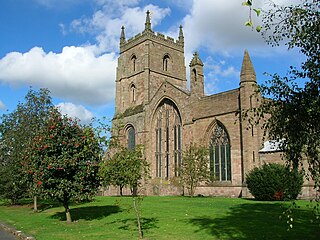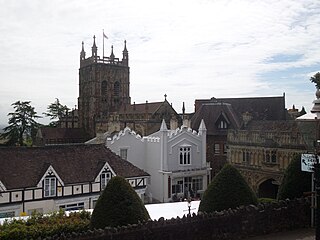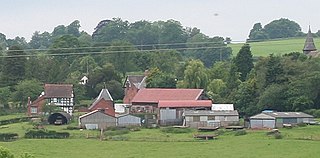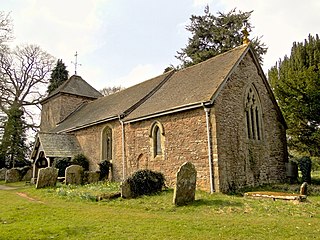
Worcestershire is a ceremonial county in the West Midlands of England. It is bordered by Shropshire, Staffordshire, and the West Midlands county to the north, Warwickshire to the east, Gloucestershire to the south, and Herefordshire to the west. The city of Worcester is the largest settlement and the county town.

Leominster is a market town in Herefordshire, England; it is located at the confluence of the River Lugg and its tributary the River Kenwater. The town is 12 miles north of Hereford and 7 miles south of Ludlow in Shropshire. With a population of 11,700, Leominster is the largest of the five towns in the county; the others being Ross-on-Wye, Ledbury, Bromyard and Kington.

The River Teme rises in Mid Wales, south of Newtown, and flows southeast roughly forming the border between England and Wales for several miles through Knighton before entering England in the vicinity of Bucknell and continuing east to Ludlow in Shropshire. From there, it flows to the north of Tenbury Wells on the Shropshire/Worcestershire border on its way to join the River Severn south of Worcester. The whole of the River Teme was designated as an SSSI by English Nature in 1996.

Herefordshire is a ceremonial county and unitary authority in the West Midlands of England. It is bordered by Shropshire to the north, Worcestershire to the east, Gloucestershire to the south-east, and the Welsh counties of Monmouthshire and Powys to the west. The city of Hereford is the largest settlement and the county town.

Malvern Hills is a local government district in Worcestershire, England. Its council is based in the town of Malvern, and its area covers most of the western half of the county, including the outlying towns of Tenbury Wells and Upton-upon-Severn. It was originally formed in 1974 and was subject to a significant boundary reform in 1998. In the 2011 census the population of the Malvern Hills district was 74,631.

Leominster was a non-metropolitan district in Hereford and Worcester, England from 1974 to 1998. The council was based in the town of Leominster.
Lindridge is a village and civil parish in the Malvern Hills District in the north of the county of Worcestershire, England, near the Shropshire border and the town of Tenbury Wells. The parish is extensive, and includes the hamlets of Eardiston, Lindridge, and Frith Common. The area around the village is known for its extensive hop fields.

The Leominster Canal was an English canal which ran for just over 18 miles from Mamble to Leominster through 16 locks and a number of tunnels, some of which suffered engineering problems even before the canal opened. Originally, the canal was part of a much more ambitious plan to run 46 miles from Stourport to Kington.

Bockleton is a small village and civil parish in the Malvern Hills district of Worcestershire, England, five miles (8 km) south of Tenbury Wells. According to the 2021 census it had a population of 198. It is close to the Herefordshire border and is about nine miles (14 km) east of Leominster in Herefordshire.

Boraston is a small village and civil parish in Shropshire, England. It is situated in the West Midlands, approximately 0.8 mi (1.3 km) north of Worcestershire and 10 mi (16 km) east of the Herefordshire border. Nearby villages include Tenbury Wells (2 mi [3.2 km]) and Burford (1.8 mi [2.9 km]); the nearest town is Kidderminster (17 mi [27 km]). Boraston is surrounded by countryside and is less than 1 mi (1.6 km) from the River Teme.

Burford is a village and civil parish in Shropshire, England.

Newnham Bridge is a village in the parish of Knighton on Teme, near Tenbury Wells, Worcestershire, England, United Kingdom.

Clifton upon Teme is a village and civil parish in the Malvern Hills District in the county of Worcestershire, England.

Eastham bridge was a Grade II listed bridge over the River Teme at Eastham, near Tenbury Wells, Worcestershire, England. Built as a toll bridge in 1793, tolls ceased to be charged in 1907, when the bridge was purchased by Worcestershire County Council.
The Tenbury Railway was a standard gauge railway that connected Tenbury in Worcestershire, England, with the nearby main line at Woofferton. It opened in 1861. An independent railway company, the Tenbury and Bewdley Railway continued to Bewdley in Worcestershire, opening in 1864. The route formed by the two railways was sometimes referred to as the Wyre Forest line or simply the Tenbury Line.

Tenbury Wells railway station was a station in Burford, Shropshire, England. Serving the town of Tenbury Wells across the River Teme in Worcestershire, the station was opened in 1861 and closed in 1962.

Laysters is a civil parish in north-east Herefordshire, England, and approximately 15 miles (20 km) north-northeast from the city and county town of Hereford. The nearest towns are the market towns of Leominster 4.5 miles (7 km) to the south-west, and Tenbury Wells in Worcestershire, 3.5 miles (6 km) miles to the north-east. Within Letton is the Grade 1 listed Church of St Andrew. The parish was alternatively spelt 'Leysters', the ecclesiastic spelling.



















